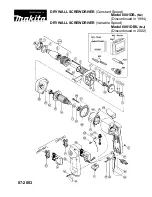
8
120 VOLT AC PORTABLE POWER
SUPPLY
Rated Versus Actual Current Draw of Equipment
Most electrical tools, appliances, electronic devices and audio/visual
equipment have labels that indicate the power consumption in amps or
watts. Be sure that the power consumption of the item to be operated is
below 500 watts. If the power consumption is rated in amps AC, simply
multiply by the AC volts (120) to determine the wattage.
Resistive loads are the easiest for this unit to run; however, it will not run
larger resistive loads (such as electric stoves and heaters), which require
far more wattage than the unit can deliver on a continuous basis. Inductive
loads (such as TVs and stereos) require more current to operate than do
resistive loads of the same wattage rating.
CAUTION:
Rechargeable Devices
• Certain rechargeable devices are designed to be charged by plugging
them directly into an AC receptacle. These devices may damage the
inverter or the charging circuit.
• When using a rechargeable device, monitor its temperature for the initial
ten minutes of use to determine if it produces excessive heat.
• If excessive heat is produced, this indicates the device should not be
used with this inverter.
• This problem does not occur with most of the battery-operated
equipment. Most of these devices use a separate charger or transformer
that is plugged into an AC receptacle.
• The inverter is capable of running most chargers and transformers.
Note:
Some laptop computers may not operate with this inverter.
Power Inverter Output Waveform
The AC output waveform of this inverter is known as a modified sine wave.
It is a stepped waveform that has characteristics similar to the sine wave
shape of utility power. This type of waveform is suitable for most AC loads,
including linear and switching power supplies used in electronic equipment,
transformers, and small motors.
Protective Features
The inverter monitors the following conditions:
Low internal battery
voltage
The inverter will automatically shut down
when the battery voltage drops too low, as
this can harm the battery.
High internal battery
voltage
The inverter will automatically shut down
when the battery voltage is too high, as this
can harm the unit.
Thermal shutdown
protection
The inverter will automatically shut down
when the unit becomes overheated.
Overload/short circuit
protection
The inverter will automatically shut down
when an overload or short circuit occurs.
IMPORTANT NOTES:
The AC Power Outlets provide a total power draw of 500W.
When the AC Power Outlets are in use, the unit will monitor for the
following fault conditions: thermal fault, low and high battery voltage fault,
overload and short circuit (refer to the “Protective Features” section).
1. If a low internal battery voltage fault condition exists, the AC Power
Outlets and the USB port will shut down automatically and the backlit
LCD screen will display the following until the fault is corrected:
The Digital Display will show the Battery Voltage Indicator; the EMPTY
Battery Status Icon and Fault Icon on the LCD Screen will flash.
2. If the high internal battery voltage fault condition exists, the AC Power
Outlets and the USB port will shut down automatically and the backlit
LCD screen will display the following until the fault is corrected:
The Digital Display will show the FULL Battery Status Icon; the “AC,”
USB icon and Fault Icon on the LCD Screen will flash.
3. If a thermal, overload or short circuit fault condition exists, the AC
Power Outlets and the USB port will shut down automatically and the
backlit LCD screen will display the following until the fault is corrected:
4. The Battery Status Icon will light solid; the “AC” and USB icon on the
Digital Display and the Fault Icon on the LCD Screen will flash.
Should any of the above fault conditions occur:
1. Disconnect the appliance from the unit.
2. Press the AC/USB Power Button to turn the AC Power Outlets off.
3. Make sure the unit does not need to be recharged.
4. Allow the unit to cool down for several minutes.
5. Make sure the rating of the appliance plugged into the unit is 500 watts
or lower and that the appliance cord and plug are not damaged.
6. Assure there is adequate ventilation around the unit before proceeding.
Using the 120 Volt AC Outlets
The 120 Volt AC Outlets are located on the front of the unit. The outlets
support a maximum power draw of 500 watts.
1. Press the AC/USB Power Button to turn on the 120V AC Power Outlets.
A beep will sound and the LCD Screen will display the following:
The Battery Status Icon lights solid and the Digital Display shows “AC”
and USB icon, indicating the AC outlet is ready to use.
2. Insert the 120 volt AC plug from the appliance into the 120 Volt AC
Outlets.
3. Switch on the appliance and operate as usual.
Note:
Ensure that the wattage of the equipment plugged into the 120V AC Power
Outlets do not exceed 500 watts continuous.
4. Press the AC/USB Power Button again to turn off the 120V AC Power
Outlets.
Periodically check the unit’s Battery Status on the backlit LCD screen. Four
solid bars in the battery icon indicates a full battery. When the battery level
is nearly empty with only one solid bar or completely empty with 4 empty
bars, the unit must be recharged at this time or the unit’s built-in low
voltage protection will activate. The empty Battery Status Icon will flash for
a short period of time before automatic shut down.
IMPORTANT:
Make sure the AC Power Outlets are turned off when the unit
is being recharged or stored.
12 VOLT DC PORTABLE POWER
SUPPLY
The 12 volt DC power supply is located under a protective cover on the
front of the unit. Refer to the Features section to locate.
This portable power source is also for use with all 12 volt DC accessories
equipped with a male accessory outlet plug and rated up to 5 amps.
1. Lift up the cover of the unit’s 12 volt DC outlet.
2. Insert the 12 volt DC plug from the appliance into the 12 volt accessory
outlet on the unit. DO NOT EXCEED A 5 AMP LOAD.
3. Switch on the appliance and operate as usual.
4. Periodically check the unit’s Battery Status on the LCD screen by
pressing the Battery Status Button. (Four solid bars in the battery icon
indicates a full battery. One bar indicates that the unit needs to be
recharged.)
Summary of Contents for PPRH5B
Page 13: ...12 ...










































